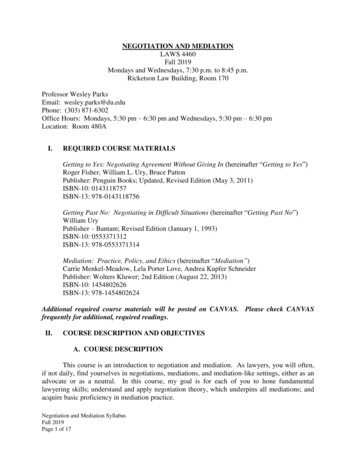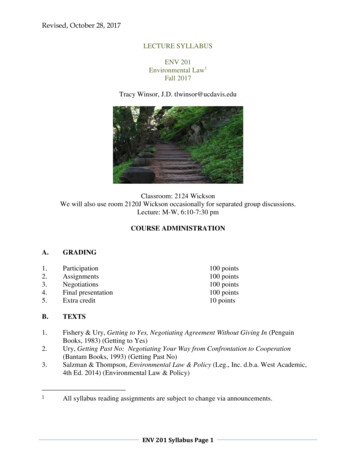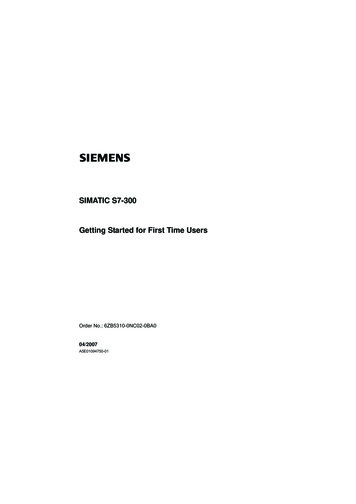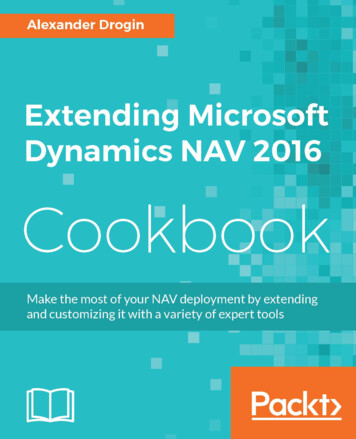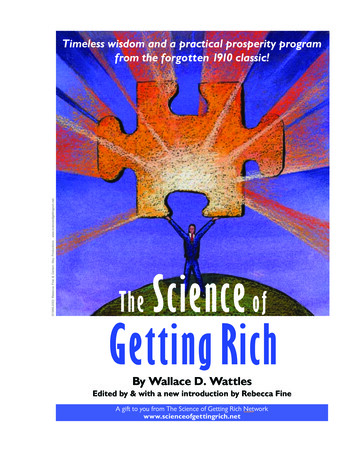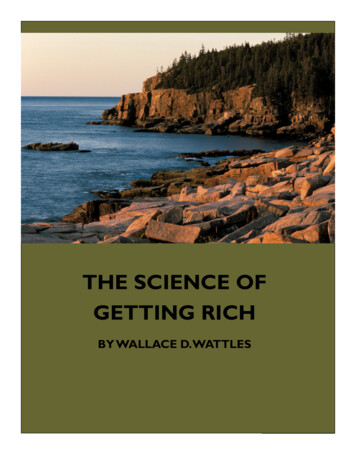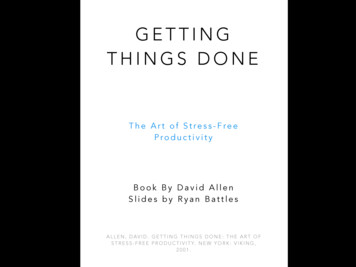
Transcription
Research Bulletin 2014The Latest in Enterprise Learning & Talent ManagementDecember 3, 2014Getting from 70-20-10 toContinuous LearningAbout the AuthorLearning and development (L&D) departments are in a constantstruggle to ensure workers have the right knowledge and skills to keeptheir organizations competitive. Over the last 30 years or so, the70-20-10 learning development model has found its way into therepertoire of almost all L&D professionals, shaping corporate learningto some extent. However, for all the good this model has done, L&Dfunctions should now consider moving past 70-20-10 to a more holisticDani JohnsonResearch ManagerBersin by DeloitteDeloitte Consulting LLPand externally focused continuous learning approach.This research bulletin discusses: How the 70-20-10 approach is falling short How a continuous learning model can more effectively serve theneeds of learners and organizations How organizations can move from 70-20-10 to continuous learningBERSIN BY DELOITTE180 GRAND AVENUESUITE 320OAKLAND, CA 94612(510) 251-4400INFO@BERSIN.COMWWW.BERSIN.COMCopyright 2014 Deloitte Development LLC. All rights reserved. Not for DistributionLicensed Material Available to Research Members Only.
Research Bulletin 2014What’s Wrong with 70-20-10?The 70-20-10 approach is a model of development in which 70 percentof learning happens in the workplace through practice and on-thejob experiences; 20 percent comes through other people via coaching,feedback, and networking; and 10 percent is delivered through formallearning interventions (see Figure 1).Figure 1: The 70-20-10 Learning Model10% FormalLearning20% Learningfrom Others70% Learningin the WorkplaceSource: Bersin by Deloitte, 2014.The true origins of this model are a bit obscure. By most accounts, itwas developed by Morgan McCall, Robert W. Eichinger, and Michael M.Lombardo in conjunction with the Center for Creative Leadership duringthe 1980s1 and formalized in the book The Career Architect DevelopmentPlanner, 3rd Edition, in 2000. The concept is also attributed to a 1998Bureau of Labor Statistics report referencing research from 1993 to1994 that suggests people learn 70 percent of their job skills informally.2Finally, Allen Tough has also been credited with the original idea asdescribed in his 1979 book The Adult’s Learning Projects.31Source: “Learning Philosophy,” Princeton University Human Resources, June 21, urce: Informal Training: A Review of Existing Data and Some New Evidence, U.S.Department of Labor Bureau of Labor Statistics / Mark A. Loewenstein and James R.Spletzer, June 1994, www.bls.gov/ore/abstract/ec/ec940090.htm.3Source: The Adult’s Learning Projects: A Fresh Approach to Theory and Practice in AdultLearning, Allen Tough / Pfeiffer & Co., April 1979.Getting from 70-20-10 to Continuous LearningDani Johnson Page 2Copyright 2014 Deloitte Development LLC. All rights reserved. Not for DistributionLicensed Material Available to Research Members Only.
Research Bulletin 2014More startling than its unclear history, however, is the lack ofempirical data supporting this approach. In a DeakinPrime whitepaper entitled Demystifying 70:20:10 4, authors Kelly Kajewski andValerie Madsen conclude:“From our review it is clear that there is a lack ofempirical data supporting 70:20:10 and, while theabove mentioned sources are frequently credited,there is also a lack of certainty about the origin.”KEY POINTDespite the lack ofempirical evidenceto support itsuse, 70-20-10 hasDespite this lack of evidence, the 70-20-10 learning development modelhas been the common-sense rule of thumb utilized by L&D practitionersfor the last few decades. In fact, L&D is steeped in the ways of thisapproach. Learning assets are regularly classified using this model,learning programs are built to it, and discussions abound concerning theright metrics to use to track the elusive 70 percent of the model. To alarge extent, 70-20-10 has shaped the way we design corporate learning.shaped the way wedesign corporatelearning to a largeextent.However, in our conversations with L&D organizations, we’re seeingthat this model can only go so far in aiding development before itbegins to hamper progress. The decreasing effectiveness of 70-20-10happens for three main reasons:1. L&D functions often use this approach prescriptively. Many L&Ddepartments tend to take this model too literally, using it as aguideline for the overall mix of their learning portfolio. The 70-20-10formula is often applied regardless of learner needs, industry, ormanagement level.2. The focus of this model is internal. Focusing on a 70-20-10formula can lead to loss of perspective. The goal of L&D is notto provide training in (or to divide training programs into) thesethree quantities; rather, the goal is to develop worker knowledgeand skills that will make the organization more competitive.Additionally, 70-20-10 places an emphasis on what is being createdrather than on how people are being developed.4Source: “Demystifying 70:20:10,” DeakinPrime / Kelly Kajewski and Valerie Madsen, June2013, http://deakinprime.com/media/47821/002978 dpw 70-20-10wp v01 fa.pdf.Getting from 70-20-10 to Continuous LearningDani Johnson Page 3Copyright 2014 Deloitte Development LLC. All rights reserved. Not for DistributionLicensed Material Available to Research Members Only.
Research Bulletin 20143. A 70-20-10 approach can isolate L&D and take responsibility offother stakeholders. This type of model often isolates L&D, makingit responsible for the creation, delivery, and success of learninginitiatives without providing for collaboration with other pertinentstakeholders, such as line management, HR, talent management,and even learners themselves.KEY POINTOur intent here is not to disparage any of the great work organizationshave done implementing a 70-20-10 model or any of the successesThe 70-20-10they have seen as a result. In fact, in its purest form, we don’t thinkmodel encourages70-20-10 is a bad idea. This concept has helped L&D departments movean L&D-centricperspective thathinders thefrom a fully formal approach to training and development to one thatacknowledges and utilizes other resources to help workers improvetheir capabilities.developmentWe do think, however, that this model encourages an L&D-centricof learners—perspective that hinders the development of learners—and thereforeand thereforeorganizations—over time. We think there is a better way to encourageorganizations—the correct mindset and make it easier for L&D to focus on bothover time.business priorities and the learner experience. This approach is referredto as “continuous learning.”What Is Continuous Learning? DEFINITIONContinuous learning is defined as “structuring resources, expectations,and learning culture in such a way as to encourage employees to learnContinuouscontinuously throughout their tenure with the organization.”5 Inlearning is definedother words, unlike traditional training, continuous learning considersas “structuringlearning to be a process rather than a series of programs (see ourresources,Continuous Learning Model, Figure 2).expectations, andlearning culturein such a way asto encourageemployees tolearn continuouslythroughout theirtenure with theorganization.”5For more information, The Learning Architecture: Defining Development and EnablingContinuous Learning, Bersin by Deloitte / David Mallon and Dani Johnson, May 2014.Available to research members at www.bersin.com/library.Getting from 70-20-10 to Continuous LearningDani Johnson Page 4Copyright 2014 Deloitte Development LLC. All rights reserved. Not for DistributionLicensed Material Available to Research Members Only.
Research Bulletin 2014TNIOEXPOREEDAImmediateSUUCFigure 2: The Continuous Learning ModelPerformance support and other tools forpoint-of-need learningQ. What do I need to support my successin the moment?IntermediateCurrent job development and competency expansionQ. What do I need to grow in my current role?ENCENONIEVIRTransitionalDevelopment of skills and relationships that will meetlong-term business goalsQ. What do I need to grow in my career?MENTSource: Bersin by Deloitte, 2013.All seasoned L&D professionals know employees learn constantly and inmany different ways. In fact, this is what spawned the 70-20-10 learningmodel in the first place. Our Continuous Learning Model takes thereality of constant learning into account in two ways:1. The model accounts for different types of learner needs. Forexample, not all needs require a 30-minute e-learning course. Ourmodel classifies needs into three main categories, represented bythe concentric circles shown in Figure 26:6We should clarify that these three categories do not indicate skill level. While thoseat a higher management level may find that more of their development activities aretransitional, the model is descriptive, not prescriptive. Employees at all levels should findthemselves jumping between all of these categories. This model allows all stakeholders—workers, line management, L&D, and talent management—to take stock of availableactivities and tailor learning and development opportunities based on their own interests,as well as business needs.Getting from 70-20-10 to Continuous LearningDani Johnson Page 5Copyright 2014 Deloitte Development LLC. All rights reserved. Not for DistributionLicensed Material Available to Research Members Only.EXPER
Research Bulletin 2014oImmediate. What learners need to be successful in their jobsright now.oIntermediate. What learners need to progress in their currentpositions, expand their competencies, and develop their owncareer interests.oTransitional. What learners need to meet long-term businessgoals or systemic jumps (such as a new role or a career shift).2. The model describes paradigms, or contexts, in which employeeslearn. Not all learning happens (or should happen) within the wallsof a classroom. Our Continuous Learning Model addresses fourparadigms, referred to as the “Four Es”:oEducation encompasses elements we often think of in thecontext of learning and development. These elements generallyhave a defined beginning and end, and can be tracked.oExperience includes elements that generally occur whileemployees are in the workplace and may include things such asstretch assignments, job rotations, and special projects.oExposure comprises learning elements that involve interactionand relationships. It helps employees develop by buildingconnections with other professionals and thought leaders.oEnvironment covers tools, systems, and other infrastructureemployees use on the job to learn or support them in their work.This emphasis on different types of learning needs and the paradigmsor contexts in which employees learn gives a continuous learning modelsome distinct advantages over the 70-20-10 approach, such as: Focusing externally and holistically on how people are beingdeveloped. While 70-20-10 focuses on what L&D produces, thepurpose of the continuous learning model is to view learningthrough the context of the four Es described earlier and to managethose paradigms to ensure consistent learning over an employee’stenure with the organization.Getting from 70-20-10 to Continuous LearningDani Johnson Page 6Copyright 2014 Deloitte Development LLC. All rights reserved. Not for DistributionLicensed Material Available to Research Members Only.
Research Bulletin 2014 Emphasizing the learning experience. Instead of focusing on assets,the continuous learning model addresses the learning experienceas a whole and provides the right kinds of learning approachesfor specific learners at specific points in time in their careers.Continuous learning moves away from thinking programmaticallyaltogether and allows for personalization in learning experiences. Insisting on collaboration. Instead of relying only on L&D to produce,deliver, and measure all learning and development, continuouslearning involves all stakeholders, including L&D, line management,learners themselves, and the organization as a whole. Continuouslearning is about ensuring everyone is on the same page about theorganization’s learning culture, processes, inputs, and outputs. Providing expectations and priorities that are descriptive ratherthan prescriptive. A well-defined continuous learning model offersL&D, the organization, and learners with a map for development.It sets expectations and priorities but does not generally prescribesome types of learning over others.Adopting a continuous learning model can change the focus of an L&Ddepartment from internal to external; from learning assets to learningexperiences; from isolation to collaboration; and from prescriptiveto descriptive. But how do organizations move from 70-20-10 tocontinuous learning?Moving to a Continuous Learning ModelMoving from a 70-20-10 model to a continuous learning approach willrequire effort and change on the part of both L&D and the rest of theorganization. The good news is there is incentive for all stakeholders toevolve the learning model. The other good news is that this evolutiondoes not have to happen all at once. Changes in mindset and culturetake time. We recommend beginning with three relatively small actions:1. Claim responsibility for organizational learning.2. Change your vocabulary and mindset.3. Involve and coordinate with stakeholders outside of L&D.Getting from 70-20-10 to Continuous LearningDani Johnson Page 7Copyright 2014 Deloitte Development LLC. All rights reserved. Not for DistributionLicensed Material Available to Research Members Only.
Research Bulletin 2014Claim Responsibility for Organizational LearningL&D professionals have a good handle on the learning they areresponsible for creating and distributing (items that generally fall intothe education and environment quadrants) but often are not muchinvolved in developing or accounting for learning that happens in theexperience or exposure quadrants.What’s more, business units and functions often seek and purchase theirown learning solutions. This siloing often means L&D is not even aware ofall the educational activities happening within their organization. Claimingresponsibility begins with taking stock of what learning and developmentis happening whether L&D is currently responsible for it or not. LEADING PRACTICEL&D shouldsee itself as theenabler for alllearning within theorganization.We are not suggesting that L&D wrestle mentoring programsaway from the talent management function if that is where thoseprograms currently reside. We know not all learning managementand development will fall under the stewardship of L&D. However,unless L&D understands the learning opportunities available withinall four quadrants and in all areas of the company, it is difficult, if notimpossible, to establish continuous learning as a functional idea. L&Dshould see itself as the enabler for all learning within the organization.Change Your Vocabulary and MindsetKEY POINTL&D shouldbegin to speakof “enabling”learning instead ofOur second recommendation is to begin speaking about learningdifferently. This applies both within the L&D department and incommunication with the larger organization. Replace terms such as70-20-10, formal, and informal with vocabulary such as continuouslearning, learner experience, education, experience, exposure, andenvironment. L&D should begin to speak of “enabling” learning insteadof “delivering” it.“delivering” it.Changing language can go a long way to helping an organization thinkdifferently about the role of L&D and learning. For example, when wesay formal learning, L&D professionals most likely think about classroomtraining, e-learning, or simulations. Under the 70-20-10 model, L&Dprofessionals attempt to ensure no more than 10 percent of the learningportfolio falls within this category. However, if we reorganize learningapproaches into the paradigms introduced by the continuous learningmodel, new possibilities open up (as shown in Figures 3, 4, and 5).Getting from 70-20-10 to Continuous LearningDani Johnson Page 8Copyright 2014 Deloitte Development LLC. All rights reserved. Not for DistributionLicensed Material Available to Research Members Only.
Research Bulletin 2014Figure 3: Traditionally “Formal” Learning Approaches and Alignment with the Four EsInstructorLedTraining(ILT) ationsEducationExperienceILT / classroom trainingis the most traditionalof L&D offerings. Itplays an importantrole in providingkey information andteaching key skills.Reflection activities,journaling, andmanagement checkins can be built intoclassroom training toextend the learningexperience and make itapplicable on the job.ExposureEnvironmentExecutive educationcan be consideredclassroom trainingbut also exposesemployees to newideas and the latestfrom thought leadersand peers in otherorganizations.In the past, e-learninghas fallen into the“formal” trainingbucket. As part of theeducation componentof L&D, it can be usedto provide consistentinformation acrosslarge audiences.Virtual classroomscan provide formalinstruction to smaller,geographicallydispersed audiences.Short e-learningcourses can be createdand used as a part ofasset libraries.Virtual classroomscan be collaborationtools for employees insimilar job functions tolearn from each otherand share leadingpractices.Simulations fallprimarily in theeducation bucket.Whether in theclassroom or online,simulations providea safe environmentin which learners canpractice new skills andapply new knowledge.Source: Bersin by Deloitte, 2014.Getting from 70-20-10 to Continuous LearningDani Johnson Page 9Copyright 2014 Deloitte Development LLC. All rights reserved. Not for DistributionLicensed Material Available to Research Members Only.
Research Bulletin 2014Figure 4: Traditionally “Informal” or “Coaching / Mentoring” Learning Approaches and Alignment with theFour EsEducationExperienceExposureEnvironmentJob AidsDigital AssetLibrariesCommunitiesof PracticeJob aids and deskprocedures can helpnewer employees togain their footing in thebeginning. They can alsobe used for referencethroughout their tenure.Animations, videos, andhandouts generatedas a part of an ILT ore-learning course can berepurposed as part of adigital asset library.As with job aids, digitalasset libraries can beused to provide short,uniform instructionon how to accomplishcertain tasks.Communities of practiceprovide opportunitiesfor employees to giveand receive feedback onchallenges they face intheir positions.ProfessionalOrganizationsMentoring /CoachingCommunities of practiceprovide opportunities tonetwork and learn fromthose within similarindustries or functions.Participationin professionalorganizations exposesemployees to the latestin leading practicesand thought leadership.It also encouragesemployees to connectwith others in their fieldwho they can then go tofor help when needed.Coaching fromsupervisors on the jobfacilitates learning.Mentors providedvia formal mentoringprograms are a wayto both build workers’learning networkswithin an organizationand borrow mentors’networks for growthexperiences.Source: Bersin by Deloitte, 2014.Getting from 70-20-10 to Continuous LearningDani Johnson Page 10Copyright 2014 Deloitte Development LLC. All rights reserved. Not for DistributionLicensed Material Available to Research Members Only.
Research Bulletin 2014Figure 5: Traditionally “On-the-Job” Learning Approaches and Alignment with the Four EsEducationStretch assignmentsprovide opportunitiesfor workers to gainon-the-job experiencefor their current role,as well as to preparefor future roles.StretchAssignmentsSearch engines, socialmedia, and discussiongroups can beintegrated into existingformal education toextend the learningexperience and helpemployees to buildprofessional networks.ShadowingChecklists andCompetencyModelsExposureEnvironmentStretch assignmentsoften require workersto move outsidetheir comfort zoneand create newconnections that willhelp them in theirdevelopment.Job rotations,particularly throughdifferent organizationalfunctions, give workersnew perspectives.Job RotationsSearchEngines /Social Media /DiscussionGroupsExperienceChecklists andcompetency modelscan be introducedusing formal trainingand reinforced throughexperience andexposure.Discussion groupsand social mediacan be leveragedin communities ofpractice to developworkers in their currentassignments.Professional socialmedia groups canbe leveraged to helpworkers build networksand expose them tothe latest thinking.Job shadowingmentors or others canexpose workers tonew roles and help totransfer knowledge.Job shadowing canhelp workers buildtheir networks.Checklists andcompetency modelscan provide structurefor the developmentof workers withina specific job. Theyalso provide a vehiclefor guidance andfeedback, as well ascorrective actionswhen needed.Learning managementsystems (LMSs)and other deliveryplatforms canincorporate search,social media, anddiscussion groups tohelp learners find whatthey need when theyneed it.Checklists andcompetency modelscan be made availableas reference tools.Source: Bersin by Deloitte, 2014.Getting from 70-20-10 to Continuous LearningDani Johnson Page 11Copyright 2014 Deloitte Development LLC. All rights reserved. Not for DistributionLicensed Material Available to Research Members Only.
Research Bulletin 2014While these three figures are not comprehensive, they do show howa change in mindset away from the categories set forth by 70-20-10can give L&D professionals new options to enable continuous learning.For example, learning approaches can be utilized in more than oneparadigm or context; learning assets, software, or infrastructure canserve more than one purpose; and L&D professionals may be better ableto understand how to create holistic and targeted solutions that serveboth learners and the organization.Involve and Coordinate with Stakeholders Outside of L&DOur final recommendation for shifting from a 70-20-10 learning modelto a continuous learning approach is to involve and coordinate withstakeholders. This is crucial, as L&D cannot be everywhere and does nothave direct supervision over all learning activities. In essence, it “takes avillage” to train workers.KEY POINTWhile L&D shouldtake responsibilityfor overallWhile L&D should take responsibility for overall organizational learning,this does not mean they must execute everything by themselves. Theyshould seek input from several functions and coordinate with othergroups in order to make these changes happen. For example: approaches that fall into the exposure and experience paradigms.organizationalLine managers are also an excellent source of informationlearning, thisconcerning the types of knowledge and skills that should bedoes not meanthey must executeeverything byLine management has a large role to play when it comes to learningdeveloped to meet business needs. Talent management often owns several of the programs that fallunder the experience and exposure paradigms. L&D should bethemselves.aware of these programs, how they fit within continuous learning,and what kinds of supporting learning activities should be availableto complete these learning experiences. Organizational executives and leaders are responsible for settingthe strategy for the business. Understanding that strategy and thechallenges facing the business in the next five years will help toguide L&D as it fills out its portfolio. Employees should assume much more of the responsibility for theirown development. This means L&D should understand learners’Getting from 70-20-10 to Continuous LearningDani Johnson Page 12Copyright 2014 Deloitte Development LLC. All rights reserved. Not for DistributionLicensed Material Available to Research Members Only.
Research Bulletin 2014needs, motivations, goals, and habits, and should craft continuouslearning experiences so employees receive the guidance they needand are able to find resources when they need them.One final thought about the involvement of stakeholders in continuouslearning: Papers, blogs, and even our own statistics indicate that thereis a lack of trust between the majority of these stakeholders and L&Ddepartments. For whatever reason, most organizations feel L&D hasdone a poor job of meeting their needs.KEY POINTWe feel this perception might exist because of a misalignment in goalsand expectations rather than due to any incompetency on the part ofAs stakeholdersL&D. Using an explicitly stated and widely adopted continuous learningand L&D begin tomodel can help to change this disconnect. As stakeholders and L&Dcommunicate andbegin to communicate and cooperate using the common language andcooperate usingstructure that a continuous learning model offers, L&D departmentsa continuousshould be able to better align their goals with the larger goals of thelearningbusiness and better meet expectations.approach, L&DdepartmentsConclusionshould be able toToo many L&D departments that we speak with are still struggling tobetter align theirget beyond formal training methods. As helpful as 70-20-10 has beengoals and meetto get L&D to think differently about their role, it isn’t enough. Itsexpectations.L&D-centric focus, emphasis on assets and programs, and tendency toisolate L&D prevent it from being truly useful as companies face today’sbusiness challenges.Learning leaders should consider a different, more continuous learningmodel that offers many advantages, including its external focus, itscollaborative nature, and its emphasis on the learning experience.To move to a continuous model, L&D departments should focus onconsciously owning and coordinating learning in the organization—whether they have direct stewardship over a given area or not.Additionally, they should begin to modify their mindset and vocabulary,becoming familiar with and using terms that help L&D professionalsthink more broadly about learning. Finally, they should also involve otherkey stakeholders in creating and delivering learning in the organization.Getting from 70-20-10 to Continuous LearningDani Johnson Page 13Copyright 2014 Deloitte Development LLC. All rights reserved. Not for DistributionLicensed Material Available to Research Members Only.
Research Bulletin 2014 KEY TAKEAWAYS The 70-20-10 learning and development model isinadequate for today’s business environment andpresents several challenges to continued developmentand growth within an organization. Shifting from a 70-20-10 learning and developmentmodel to a continuous learning approach offers a morecomprehensive, holistic, and outwardly focused mindsetthat better allows L&D to meet business needs. To adopt a continuous learning model, L&Ddepartments must do three things:1. Take ownership of organizational learning—not justformal training.2. Shift vocabulary and mindset to align withcontinuous learning.3. Coordinate with stakeholders outside of the L&Dorganization, including line management, HR,talent management, and learners themselves,involving them in the learning process.Getting from 70-20-10 to Continuous LearningDani Johnson Page 14Copyright 2014 Deloitte Development LLC. All rights reserved. Not for DistributionLicensed Material Available to Research Members Only.
Research Bulletin 2014The Bersin WhatWorks MembershipProgramThis document is part of the Bersin Research Library. Our research isprovided exclusively to organizational members of the Bersin ResearchProgram. Member organizations have access to an extensive library oflearning and talent management related research. In addition, membersalso receive a variety of products and services to enable talent-relatedtransformation within their o rganizations, including: Research—Access to an extensive selection of research reports,such as methodologies, process models and frameworks, andcomprehensive industry studies and case studies. Benchmarking—These services cover a wide spectrum of HR andL&D metrics, customized by industry and company size. Tools—Comprehensive tools for HR and L&D professionals,including tools for benchmarking, vendor and system selection,program design, program implementation, change management,and measurement. Analyst Support—Via telephone or email, our advisory services aresupported by expert industry analysts who conduct our research. Strategic Advisory Services—Expert support for custom-tailoredprojects. Member Roundtables—A place where you can connect with otherpeers and industry leaders to discuss and learn about the latestindustry trends and leading practices. IMPACT Conference: The Business of Talent—Attendance atspecial sessions of our annual IMPACT conference. Workshops—Bersin analysts and advisors conduct onsite workshopson a wide range of topics to educate, inform, and inspire HR andL&D professionals and leaders.For more information about our membership program, please visit us atwww.bersin.com/membership.Getting from 70-20-10 to Continuous LearningDani Johnson Page 15Copyright 2014 Deloitte Development LLC. All rights reserved. Not for DistributionLicensed Material Available to Research Members Only.
Research Bulletin 2014About UsBersin by Deloitte delivers research-based people strategies designedto help leaders and their organizations in their efforts to deliverexceptional business performance. Our WhatWorks membership givesFORTUNE 1000 and Global 2000 HR professionals the informationand tools they need to design and implement leading practicesolutions, benchmark against others, develop their staff, and selectand implement systems. A piece of Bersin by Deloitte research isdownloaded on average approximately every minute during thebusiness day. More than 5,000 organizations worldwide use our researchand consulting to guide their HR, talent, and learning strategies.As used in this document, “Deloitte”
and externally focused continuous learning approach. This research bulletin discusses: How the 70-20-10 approach is falling short How a continuous learning model can more effectively serve the needs of learners and organizations How organizations can move from 70-20-10 to continuous learning Getting from 70-20-10 to Continuous Learning



